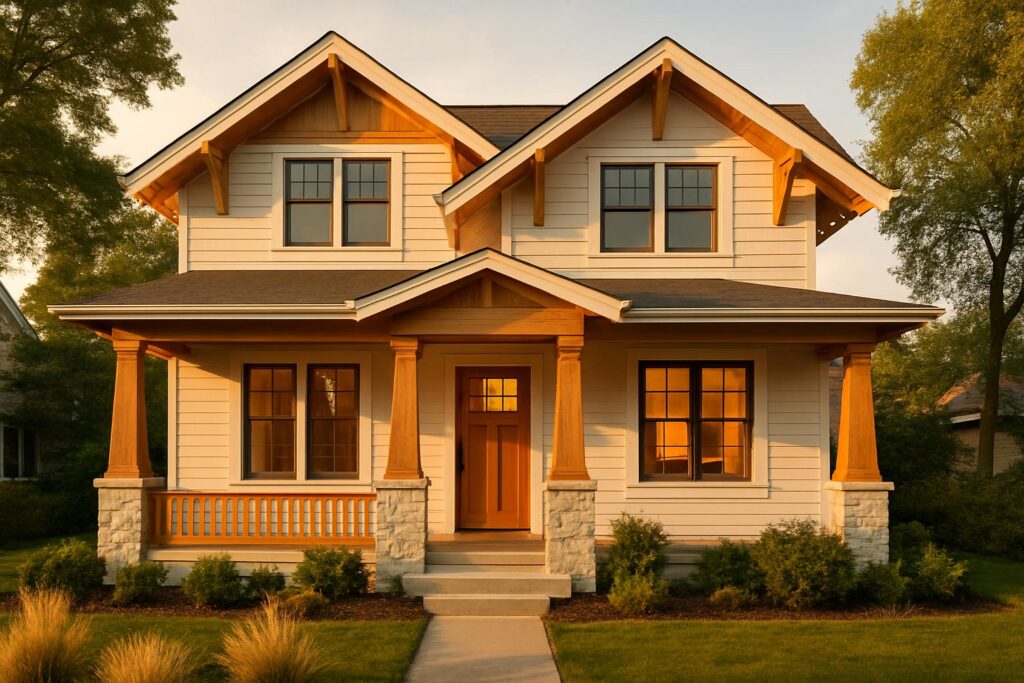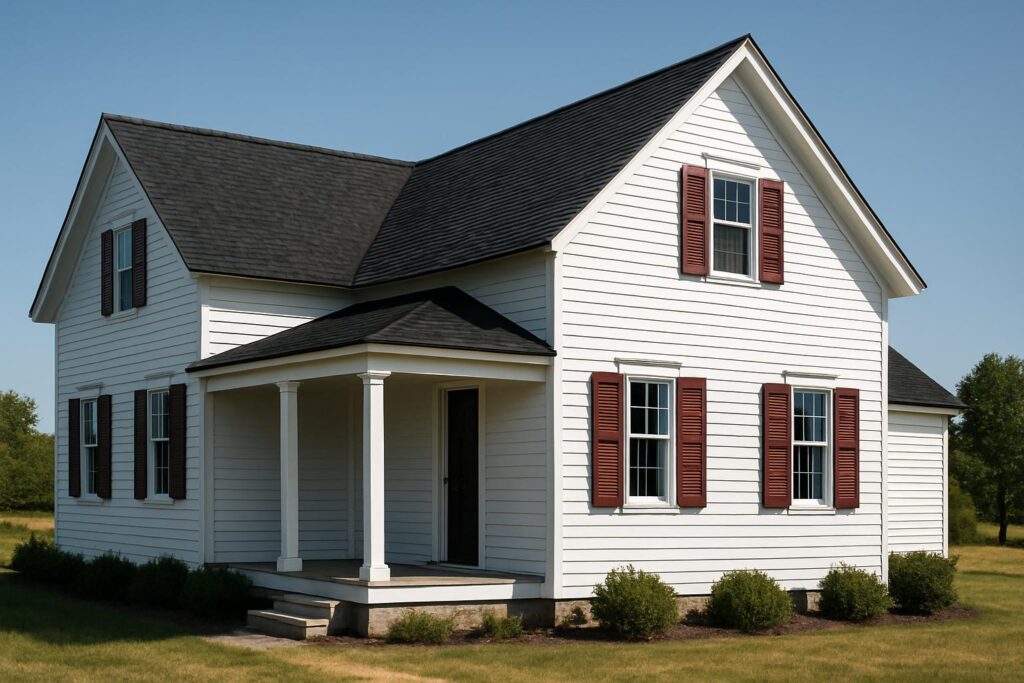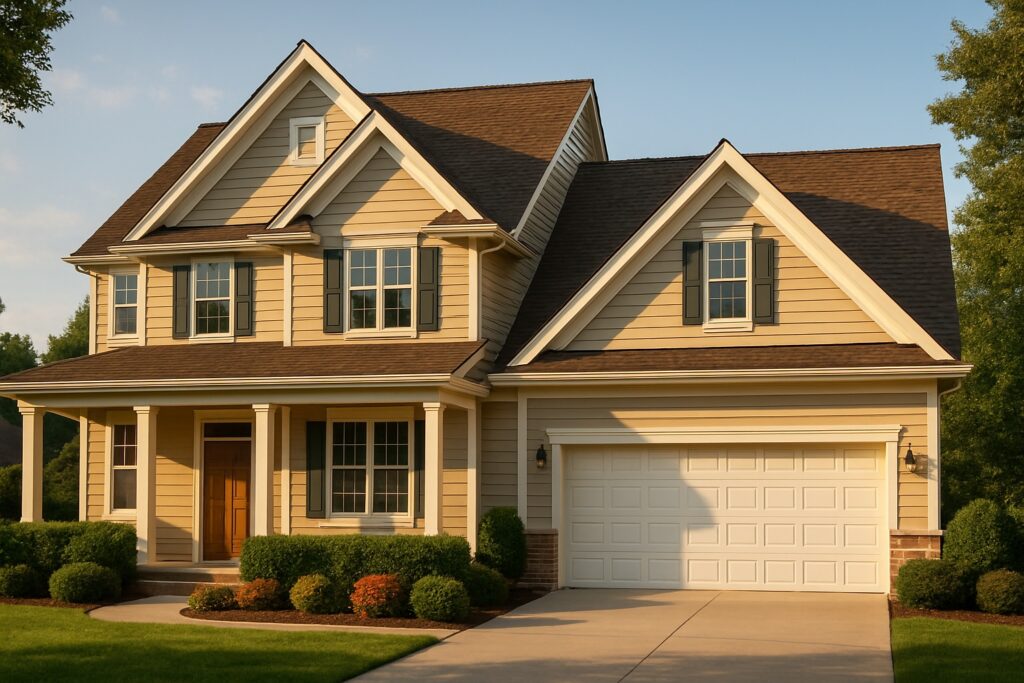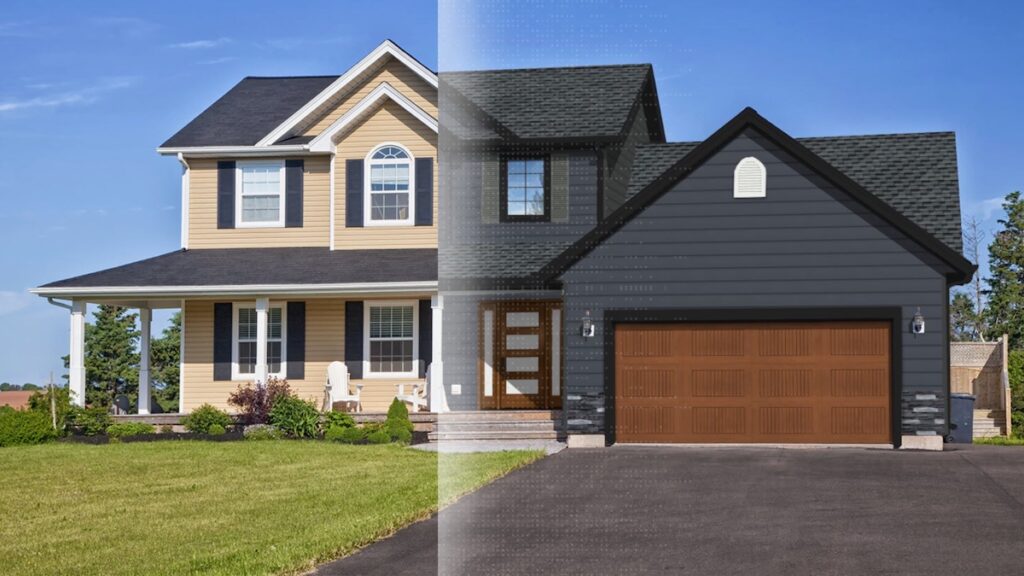TLDR
Here’s a quick snapshot of the key takeaways if you’re deciding between vinyl and aluminum siding:
Vinyl Siding – Affordable, low maintenance, and available in a wide range of colors and styles.
Aluminum Siding – Durable, fire-resistant, and great for extreme weather conditions.
Cost & Installation – Vinyl is generally cheaper and easier to install, while aluminum can be pricier but lasts longer.
Maintenance & Longevity – Vinyl resists moisture and won’t rust, while aluminum is prone to denting but won’t fade as quickly.
Energy Efficiency – Insulated vinyl improves home insulation, while aluminum reflects heat effectively.
Try Renoworks’ AI-powered siding design tool to see what works best for your home!
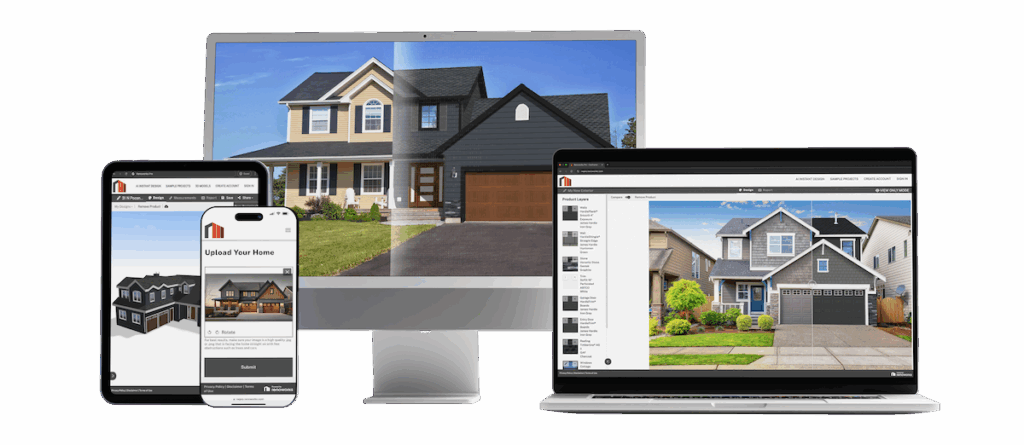
Introduction
Your home exterior matters. It shapes first impressions and sets the tone every time you pull into the driveway. If you’re choosing new cladding or siding material, you might be asking: “How much is this going to cost?”, “Will it get dinged up?”, “Will it still look good in ten years?”
Aluminum vs vinyl siding is a common debate for homeowners who want a resilient exterior without blowing the budget. Both aluminum siding and vinyl siding are durable, fire-resistant, and visually appealing. But they vary in their environmental impact, insulation, and resistance to damage. This guide dives deep into each metal and plastic-based option to help you make a confident choice.
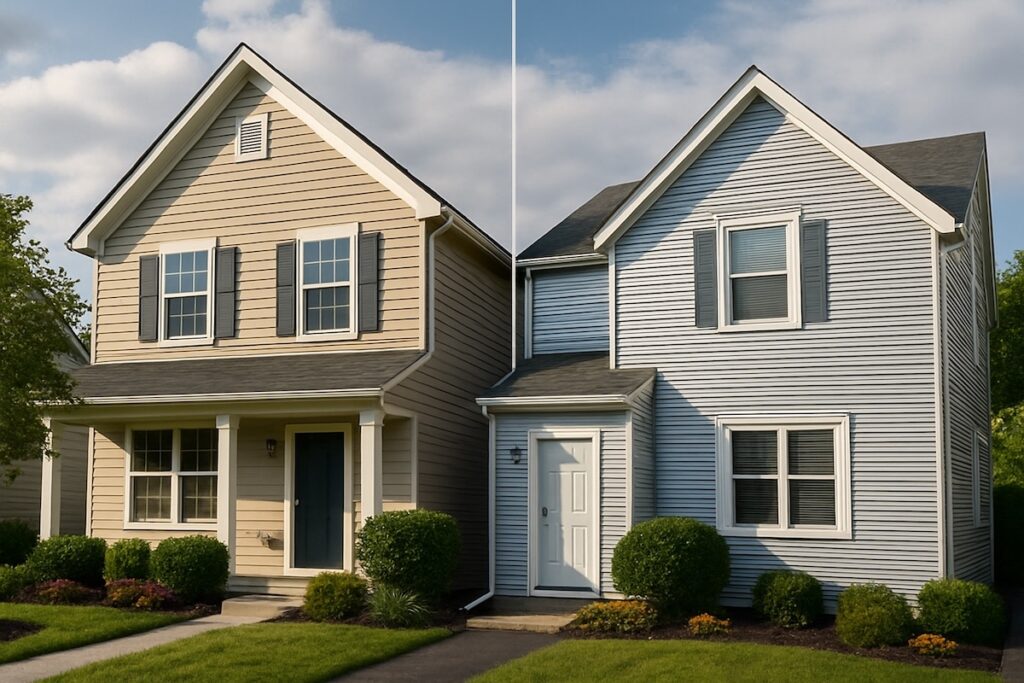
Siding Material Overview
For more inspiration on matching siding to exterior features, check out our brick and stone exterior combination ideas.
Before diving in, here’s a broader look at your siding options:
Wood Siding – Traditional, charming, but high-maintenance.
Asbestos Siding – Phased out for safety but found on older homes.
Brick – Classic and durable, often more expensive.
Steel Siding – Strong, long-lasting, modern alternative.
Engineered Wood Siding – Synthetic wood-look without the upkeep.
Metal Siding – Includes aluminum and steel, valued for longevity and fire resistance.
Aluminum and vinyl stand out for their affordability, availability, and relatively low siding costs for installation and upkeep.
Vinyl Siding in Depth
Composition & Appearance
Vinyl siding is made from polyvinyl chloride (PVC), a lightweight, flexible plastic material. It’s available in a wide range of colors, textures, and finishes—including insulated vinyl siding with foam backing for improved energy efficiency.
Durability & Maintenance
Vinyl siding is known for being water-resistant and low maintenance. It won’t rust or fade, but it can become brittle in very cold climates. Damage from hail or falling branches may lead to cracks instead of dents.
Cost Factors
Vinyl siding typically costs between $2 and $7 per square foot, including installation, depending on region, brand, and panel thickness. Premium options such as insulated vinyl siding or textured, wood-look panels can raise that price slightly, sometimes up to $9 per square foot. For a full 2,000 sq. ft. home exterior, that translates to $4,000–$14,000 total. Despite inflationary trends, vinyl siding remains one of the most cost-effective cladding materials on the market.
Insulation & Energy Efficiency
Insulated vinyl siding is one of the best siding options for improving home insulation. Foam-backed panels add R-value and can reduce heating and cooling costs.
Pros and Cons
| Pros | Cons |
|---|---|
| Affordable and lightweight | Can crack in extreme cold |
| Resists mold, rot, and pests | Limited recyclability in most areas |
| Color is baked-in—no repainting | Not as durable as steel or aluminum siding |
Aluminum Siding in Depth
Composition & Appearance
Aluminum siding is a type of metal siding made from rust-resistant aluminum sheets. It’s typically coated or painted and available in smooth or embossed faux-wood grain finishes. It also qualifies as a fire-resistant cladding material.
Durability & Maintenance
Aluminum is highly durable and doesn’t rot or rust. However, it’s prone to denting from hail, debris, or impact. Paint may fade or chalk over time, requiring maintenance every 10–15 years.
Cost Factors
Aluminum siding usually ranges from $3 to $7.50 per square foot, installed. Higher-end or thicker gauge aluminum products with specialty coatings may reach $9–$10 per square foot. For a standard 2,000 sq. ft. home, total installation can range from $6,000 to $15,000, depending on your contractor, material grade, and local labor costs. While more expensive than vinyl up front, its long-term lifespan and repaintability can offer solid ROI—especially in wildfire-prone or sun-exposed climates.
Insulation & Energy Efficiency
Aluminum reflects solar heat, making it ideal for hot climates. Pairing it with foam board insulation boosts thermal performance significantly.
Pros and Cons
| Pros | Cons |
|---|---|
| Fire-resistant and recyclable | Can dent easily and show imperfections |
| Lightweight and corrosion-resistant | Requires repainting over time |
| Reflects heat well | May be noisier during heavy rain or hail |
Aluminum vs Vinyl: Head-to-Head
Aesthetics and Curb Appeal
Vinyl offers more color and texture variety out-of-the-box, while aluminum provides a sleek, modern look with repaint flexibility. Vinyl‘s factory finish masks scratches; aluminum shows chips and may need touch-ups.
Durability and Damage Resistance
Vinyl is better at resisting dents and scratches. Aluminum withstands heat and fire better but is vulnerable to impact damage.
Maintenance and Repairs
Vinyl siding requires less frequent upkeep. Damaged panels are replaced. Aluminum may need repainting and can be patched for dents.
Cost & Lifespan
Vinyl has a lower initial cost and easier installation. Aluminum may last longer overall if well maintained, but paint maintenance adds long-term cost.
Environmental Considerations
Aluminum siding is 100% recyclable and contributes less to landfill waste. Vinyl has a lower carbon footprint during installation but is more difficult to recycle.
Other Factors to Consider
If you’re planning around your local environment, our guide to choosing siding for your climate can help refine your decision.
Local Climate
Live in a hot area? Aluminum helps reflect sunlight. Cold climate? Insulated vinyl offers better warmth retention. Humid zones need mold-resistant materials—both siding options perform well if properly installed.
Building Codes & HOAs
Need help matching your style to neighborhood trends? Explore our guide to popular exterior house colours.
Some regions regulate siding materials or require uniformity in style. Aluminum siding and vinyl siding are both commonly accepted but always check HOA rules first.
Installation & Labor
Both materials are DIY-friendly in small applications but require professional labor for full exteriors. Poor installation can lead to trapped moisture, mold, or uneven cladding.
Resale Value
Siding isn’t the only upgrade that adds curb appeal. Our metal roofing style guide shows how to complement your siding choice with premium roofing looks.
According to the 2023 Cost vs. Value Report, new siding recoups 70–80% of its value. Choose a material that looks polished, matches your architecture, and appeals to local buyers.
HOME VISUALIZER TOOL
Still Imagining? Start Designing.
Visualize your home — for free. Instantly explore siding styles, colors, and renovations with just one photo. No forms. No pressure. Just results.

Conclusion
Still exploring design possibilities? Read our house styles guide to ensure your siding choice fits your architectural vision.
There’s no universal best siding—just the best for your goals, budget, and climate. Vinyl is the go-to for homeowners who want affordable siding with minimal upkeep. Aluminum siding appeals to those seeking recyclable siding materials, high heat resistance, and a modern aesthetic.
For colder climates, insulated vinyl may offer better performance. For hot, dry areas, aluminum excels. Always weigh installation cost, long-term damage risk, maintenance demands, and resale potential.
Try the Renoworks Visualizer to preview different vinyl and metal siding styles on your own home in seconds.
Ready to start designing?
Book a Demo or explore our Siding Visualizer Tool.
Frequently Asked Questions
Q: What is the average lifespan of vinyl siding vs aluminum siding?
Vinyl siding typically lasts 20–40 years with minimal upkeep. Aluminum siding can last just as long, but may need repainting every 10–15 years.
Q: Is metal siding more fire-resistant than vinyl siding?
Yes. Aluminum siding is non-combustible and considered a fire-resistant cladding. Vinyl can melt under high heat.
Q: What’s better for resale value—vinyl or aluminum siding?
Vinyl is more commonly used and has broader buyer appeal, while aluminum may win points for recyclability and heat reflection in hot climates.
Q: Which material is more sustainable?
Aluminum is fully recyclable, making it a more environmentally friendly siding option. Vinyl is harder to recycle but has a lower carbon footprint during installation.
Q: How do steel siding and fiber cement compare to vinyl and aluminum?
Steel siding is extremely durable but heavier and costlier. Fiber cement offers a premium look but requires special tools to install. Vinyl and aluminum remain top choices for affordability and ease of installation.
Q: Does aluminum siding make noise during wind or storms?
It can. Aluminum siding may rattle slightly during strong winds or storms if not properly secured.
Q: Will vinyl siding increase my home’s energy efficiency?
Yes, especially if you choose insulated vinyl siding. Foam-backed vinyl panels improve temperature regulation and can help lower utility bills.
Q: Which siding is more durable overall?
It depends—vinyl is more flexible and resists dents; aluminum holds up against heat and pests but is more prone to scratches and hail damage.
Q: Can I install new siding over old siding?
Sometimes. Vinyl can go over wood if the surface is solid. Aluminum may require a flat subsurface. Consult a siding contractor to evaluate.
Q: How often do I repaint aluminum siding?
Every 10–15 years, depending on exposure to sunlight, moisture, and wear.
Q: Is one material better for insulation?
Insulated vinyl offers built-in thermal performance. Aluminum requires separate insulation, like foam board or house wrap, for comparable results.
Q: How easy is it to fix damage?
Vinyl panels are swapped out. Aluminum dents may need patching or replacing sections. Both repairs are best handled by a professional.



